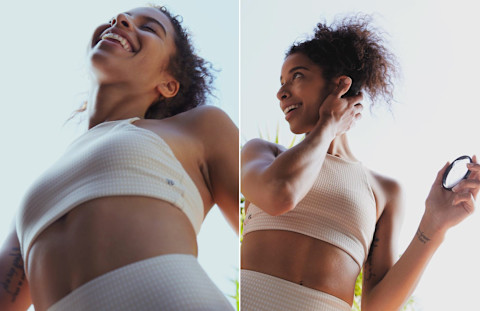Cup Curious Right Now? Relax: Here’s How To Make A Comfortable Switch

Over the course of a lifetime, the average menstruating person spends over 2,000 days (that’s about six years) on their period, racking up at least a thousand dollars on tampons alone and tossing around 300 pounds of discarded pads, packaging, and applicators—the vast majority of which contain non-biodegradable plastic and take centuries to decompose.
This probably isn’t news to you if you’re reading this post, and you might have already given some thought to your options for managing your period a little more sustainably. One such option on your radar may be switching to a menstrual cup—a flexible bell-shaped cup, usually made from silicone, that collects blood rather than absorbs it (in addition to other fluids) like a tampon. They can be worn for up to 12 hours at a time and be reused for several years before needing to be replaced. Sounds super ideal, but if the learning curve or what some folks call the “gross factor” have kept you from trying one before, now’s a great time to give it a go.
For many of us, social distancing means we’re not just limiting runs to the store , we’re also likely using our own bathrooms more than ever—which is extremely helpful for getting comfortable with your cycle and learning to use a cup confidently. Read on for a few top tips to do just that.
Find the right fit.
Menstrual cups are not a one-size-fits-all situation, and it might take a bit of research and experimenting with different brands to find one that feels comfortable and secure. Cups are available in varying sizes and shapes and range in softness and firmness.
If you’re new to using a cup, or are on the sensitive side, you may want to start out with a softer, more “squishable” option like Flex Cup, which is made with velvety-soft, form-fitting (and yep, toxin-free) silicone for more comfortable insertion, wear, and removal. Flex Cup also comes in two sizes—slim and full—and if yours doesn't fit exactly right, Flex will happily switch it out for a different size.

Do a practice run.
Trying out your cup—particularly inserting it and removing it—before your cycle starts can help prevent a lot of the awkwardness and (crampy) discomfort of figuring it all out on the first day of your period. And because the cup, unlike a tampon, is made of a silky, non-absorbent material, you will not experience the discomfort of a dry vaginal canal as you insert and remove. This dress rehearsal is the perfect time to test out and get used to a couple folding methods (the cup’s flexible opening folds up in various ways for insertion). For beginners, the easiest and quickest folds include:
- The punch-down fold. Push any point of the rim down to the base of the cup, then squeeze the sides together to hold the shape in place. This fold has one of the smallest insertion points.
- The 7 fold (or triangle fold). Squeeze the sides together to flatten the cup, then take the top right corner and fold it down towards the stem, creating a “7” or triangle shape.
If it helps, prop your foot on the toilet or squat down—just find a position you’re comfortable with. And remember to breathe to help you relax and refrain from tensing up!
Once inserted, the fold opens up (some “pop” open), creating a suction seal that allows the cup to stay in place. To make sure you get that seal, try inserting the cup slightly higher than you think you’d need to, then give it a slight tug downward. If it’s sealed, you should feel some resistance. Make sure the cup is all the way unfolded by feeling around the base of the cup—it should feel round, without any dents or folds. Otherwise, you can try rotating it from side to side to unfold and catch the seal, or just remove it and try again.
Once it’s properly in place, you shouldn’t feel any discomfort or even notice the cup at all after a minute or so (do a couple squats to ensure it’s snug and unnoticeable!). If it’s inserted correctly and you do feel discomfort, try trimming the stem down to a shorter length.
Leak-proof the first couple of go-arounds.
Inserted correctly, cups are entirely leak-free—the seal keeps menstrual blood from coming into contact with air at all (making cups an ultra-hygienic experience). But still, we get the paranoia around leaks—especially considering cups can hold three to four times as much as a regular tampon!
Many menstrual cup users empty it only once in the morning and once at night. But for peace of mind in between, wearing a liner or doubling up with leak-proof underwear can be helpful as you get used to it and feel more secure.

Mind the seal!
To remove the cup comfortably as possible—and to reduce the chance of spillage—it’s all about the seal. Again, find a position that works for you (over the toilet is great!), relax, then reach for the base of the cup. To break the suction seal, you can stick your finger around the rim or pinch the base. Continue pinching as you gently pull the cup down while moving it side to side.
The neat thing about the FLEX Cup is its beginner-friendly design: The stem is actually a pull tab for mess-free removal which breaks the seal for you instead of having to insert a finger around the cup or pinch the base. Slowly pulling the tab draws the cup in and releases the suction to help the cup glide out. Just keep the cup upright as you remove it to avoid spillage! Then, simply pour the menstrual blood into the toilet and rinse your cup before reinserting.
Don’t get discouraged if the first couple times don’t go as smoothly (or as cleanly) as you’d hoped. Give it time—at least a few cycles—to find your groove.
Go with the flow.
One of the great benefits of using a cup is the additional option it provides. While many users end up switching exclusively to cups, the whole point is to use the products that make the most sense for you, your body, and your cycle—and that might just mean rotating your products. Maybe it’s a tampon on heavy days, and a Flex Disc on light days when the lack of moisture makes removing a tampon uncomfortable.; Or maybe you’ll opt for Flex’s menstrual disc to enjoy mess-free period sex. The beauty of having these alternatives is that we can make better choices for ourselves—and yes, the planet.
